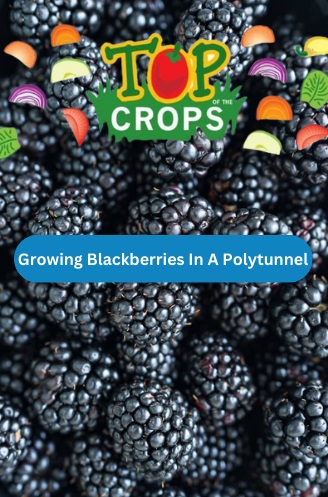Welcome to Top of the Crops - today, you will learn how to grow blackberries in a polytunnel. For more gardening insights, be sure to check out our blog Polytunnel Gardening too!
Blackberries, and the brambles they grow on, often get a bad name. Often growing into tangled thickets, creeping under fences from next door, or taking over an area of land, these plants are often thought of as a problem.
But blackberries can also be an extremely useful fruit-bearing plant to grow in your garden – perhaps even in a polytunnel or a fruit cage when you select the right variety and they are tamed and properly brought under control.
| Jan | Feb | Mar | Apr | May | Jun | Jul | Aug | Sep | Oct | Nov | Dec | |
| Plant |  |
 |
 |
 |
||||||||
| Harvest |  |
 |
 |
A number of different species within the Rubus genus and hybrids are referred to as blackberries around the world. The blackberries we grow in the UK are usually Rubus fruticosus or Rubus plicatus, the species native to Europe.
Blackberries are very similar to raspberries and other close relatives within the Rubus genus. But they differ from their raspberry relatives because the white rasp at the centre of the fruits stays with them when picked, rather than with the raspberry where the berry slips off leaving the rasp, or torus, on the plant.
Blackberries are perennial plants which typically bear stems that are biennial – growing one year and fruiting the next. The long stems can arch or trail along the ground, producing leaves but no flowers as primocanes, then becoming a floricane and flowering and bearing berries in their second year.
Many blackberries have prickles, commonly called thorns, on them, which can make these plants difficult to deal with. However, modern thornless cultivars of blackberries are now fairly widely available, making it easier for them to be grown in a garden.
Blackberries are usually planted out during the dormant period as bare root plants but you can also purchase and plant out pot grown specimens in the spring. Of course, before you can plant out blackberries you need to choose which ones to grow.
When choosing blackberries to plant, which species and variety you select can be very important. It is a good idea to look, first and foremost, at which species of blackberry are native to your area.
It is also very important to make sure that you check that any species you are considering are not a concern in your location. In certain areas, particular blackberries can be extremely problematic invasive plants, and should of course be avoided.
Remember, while all blackberries share certain characteristics and requirements in common, there are differences between them. Some grow a lot larger and more vigorously than others.
Remember, while all blackberries share certain characteristics and requirements in common, there are differences between them. Some grow a lot larger and more vigorously than others.
One important thing to understand is that cultivated blackberries and their hybrids and close relatives such as Tayberries, loganberries, boysenberries, tummelberries, dewberries and wineberries are much 'better behaved' than their wild relatives. And there are even compact varietals to choose from.
It is important to make sure that you understand how much space a blackberry plant will occupy and how quickly before you decide whether you should plant those blackberries on your property.
First of all, once your blackberries arrive or you bring them home, you need to make sure you have a suitable location ready in which to plant them.
Where you plant blackberries and why will depend in large part on whether you are considering them for a small domestic garden, or for a farm, smallholding or other larger property.
The options for growing blackberries are a lot wider and more diverse on a larger property than they are in small spaces, where blackberries can be grown, but a lot more thought and care is required to make sure that they do not outgrow their environs.
Blackberries can be very useful in a forest garden, as long as they are not allowed to take over. Pruning can allow you to grow these plants in moderately small spaces and alongside other plants without them taking over entirely. And of course they provide multiple yields in addition to the berries, making them great value plants for a garden.
In a small garden, they can even be fan trained to allow for the berries to be produced without having to deal with tangled thickets when harvesting, and to reduce the space these plants occupy overall. Of course this strategy might also be used inside a fruit cage or polytunnel.
Blackberries can also be extremely useful in reclaiming degraded land, when they are often among the first to colonise the space. They may be used successfully in certain contexts in order to speed ecological succession and work on ecosystem restoration.
They might be useful in some cases to stabilize slope and to prevent erosion. And in certain contexts that can work very well within mixed hedgerows, whether these are primarily for food, forage or fodder, and/ or wind breaking. The prickly thickets these plants can form can also help to protect property and prevent intrusion.
Of course, when deciding where to plant blackberries in a garden or on a larger property, you should consider their basic environmental needs, which we will cover below. But you also need to think about your own needs, and how you might be able to integrate blackberries into your holistic garden design.
Blackberries do typically need more space than a container can provide. However, there are some smaller cultivars that can be grown in large containers, so this is something else to consider if space is at a premium.
Blackberries ripen at different times in different areas, and depending on the specific species and variety grown. However, you can typically expect blackberries to ripen some time between mid summer and autumn.
You should have no difficulty finding things to do with all the delicious berries that you harvest. Of course, you can eat them fresh, use them in a range of recipes, sweet and savoury, or freeze or can them for later use. Here are some recipe ideas to consider.
Blackberries are relatively unfussy about conditions and so are very easy when it comes to their care. Blackberries will fruit best in full sun, but they can also cope relatively well with partial or dappled shade.
In shade, the berries are likely to be slightly less sweet, and will ripen a little later. But they are typically still produced in any light shade. Though blackberries can also grow well in deep shade they will not fruit much if at all in such conditions.
If you want to grow plenty of blackberries, and enjoy these berries over as long a season as possible, you might wish to consider growing some in full sun and some in light shade as this can prolong the harvest period.
Newly planted blackberries should be kept well watered during dry spells until they become established. However, once mature, plants growing in the ground should not require extra watering where rainfall is often sufficient.
In a particularly dry location, however, or when growing undercover or in pots, it is a good idea to water once every couple of weeks or so to ensure a good harvest.
Blackberries are relatively unfussy about the soil in which they grow and can survive and thrive in a wide range of conditions.
They prefer a moist yet free draining soil and yet can tolerate drought, and while they love a mildly acid or neutral soil pH, can cope well with both very acidic and very alkaline conditions. They will thrive in a fertile soil and yet can also tolerate nutritionally poor conditions.
However, adding an organic mulch around blackberries can help ensure that they and the soil below them remain healthy over time.
Most of the time it will not be necessary to feed blackberries as they can derive what they need from the organic mulch and a reasonably fertile soil.
Blackberries can be propagated most easily by tip layering. This is the main method by which blackberries propagate themselves in the wild. Where nodes at the end of shoot tips bend down and remain in contact with the soil, new roots will form.
We can encourage this layering to take place by pegging a stem down so that it remains in the soil. Once roots form the new plant can be severed from its parent and moved elsewhere.
Alternatively, some blackberries can also be grown from seed. Though plants grown from seed may not always have precisely the same characteristics as the parent plant.
Blackberries are hardy and resilient plants that will not need a lot of protection. However, a fruit cage or polytunnel can help to make sure that the wildlife – birds, rodents etc. does not eat all the berries before you get the chance to harvest.
Most blackberries, remember, fruit on the canes that grew during the previous season (floricane). There are exceptions however, and primocane blackberry varieties have been developed that have different pruning requirements.
Floricane blackberries are typically treated as followed when training and pruned for a garden setting:
In the first year, shoots of newly planted canes are tied in regularly. During the first winter, all side shoots produced on these main canes are but back to 5cm long. Fruits will mostly form on the resulting spurs.
In the second year after planting, new canes will grow up from the soil level. These are bundled and managed carefully, then pruned after they have fruited, the stems that have produced berries are pruned out without disturbing new canes. The new canes can then be tied in and trained along the wires of the support system.
Of course, in other settings, blackberries can of course be left almost entirely or entirely undisturbed, where they will become a haven for a wide range of local wildlife.
Some highly regarded blackberry varieties for the UK are:
Blackberries can thrive in spite of a wide range of problems and pests. However, there are some that can be be more troublesome than others. Pests that feed of blackberries include aphids, raspberry beetles, raspberry leaf and bud mites, red berry mites and fruit flies. Birds can also become a pest.
Remember, for pest control in an organic garden, boosting biodiversity to keep the ecosystem in balance is always the first and most important step. Though sometimes, physical barriers may be required if wildlife gets all the berries before you get the chance to harvest.
When it comes to diseases, some common problems for blackberries include raspberry cane blight, phytophthora root rot, verticillium wilt, and honey fungus. Raspberry cane and leaf spot can also impact blackberries and lookalike purple blotch is another potential issue.
For many, blackberries are a foraged fruit rather than something to cultivate in the garden. But growing these berries more formally in a polytunnel or fruit cage can be a great choice for easy and abundant yields. Just make sure you choose the right variety and train and prune it correctly to make sure that things do not get out of control.
Countryfile. (2023) Blackberry guide: where to find, how to cook and recipe ideas. [online] Available at: https://www.countryfile.com/how-to/food-recipes/blackberry-guide-and-recipe-ideas
